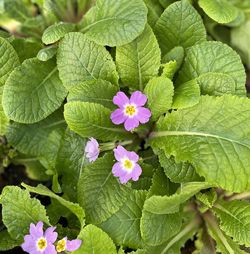Rudbeckia
Black-Eyed Susan
Named by Linnaeus in honor of his teacher Olaf Rudbeck, this North American genus includes 25 to 30 species, many of them famous summer and late season bloomers. These easily grown selections promise to brighten borders and naturalized meadows plus make dandy additions to bouquets. Offering late fall and winter interest, they combine well with Asters, Eupatoriums and grasses.
Rudbeckia ‘American Gold Rush’ (P-2110)
Each $11.00
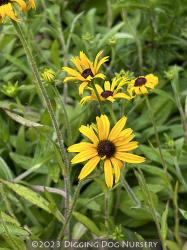
Distinguished from its seed parent by smaller leaves, a compact, shorter stature and superb resistance to leaf spot, this new Intrinsic Perennials introduction is creating quite a stir. The well-groomed dome-like habit sports slender hirsute greenery plus an ebullient showing of copious, ebony-centered bright golden-yellow daisies from summer ’til fall. Enticing plant purveyors, butterflies and songbirds, ‘American Gold Rush’ is a steadfast long-lived perennial for borders, cutting gardens or natural-style plantings. (pp#28,498)
Blooms July–September
Size: 18" – 2' 0" high x 18" – 2' 0" wide.
Hardy to zone 4.
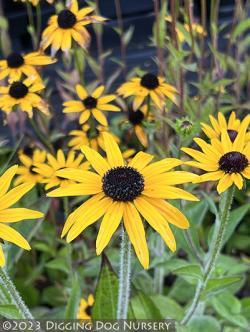
A resilient central and southeastern U.S. native, this undemanding queen of yellow wields her scepter over the late season garden. Each glorious, large golden disc hosts a pronounced velvety dark chocolate center and 12 to 21 ebullient rays. Crowning strong, branched upright stems and hairy, oblong thick dark green leaves, the intriguing pointed green calyces unfurl a profuse sunny gala that entrances butterflies, song birds, florists and plant enthusiasts. Adaptable Deam’s Black-Eyed Susan can be added to stylized meadows, perennial borders and cottage gardens, where she thwarts pests and tolerates occasional drought plus clay or rocky soil.
Blooms July–September
Size: 2-1/2' – 3' 0" high x 15" wide.
Hardy to zone 3.
Rudbeckia fulgida speciosa (Newmanii) (P-0552)
Each $11.00
-854.jpg)
Somewhat wilder looking than most of the well-known cultivars, this species holds bright orange-yellow flowers with densely clustered petals on strong, wiry stems. In our garden, its open habit is backed by Persicaria ‘Summer Dance’.
Blooms late July–September.
Size: 2' 0" high x 2' 0" wide.
Hardy to zone 4.
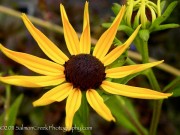
You probably know ‘Swiss Gold’ as Black-Eyed Susan, those robust, bright orange-yellow American daisies with the dark centers. As charming in seed as it is in flower, its abundant chocolate-brown seed heads last until Thanksgiving. Strong stems bear flowers almost 3 ft. high without staking; foliage is dark green and hirsute.
Set a meadow ablaze with a large drift. Effective with Eupatorium ‘Gateway’, Aster ‘Coombe Fishacre’ and Deschampsia ‘Goldgehänge’ for texture.
Blooms August–October.
Size: 2-1/2' high x 0" & spreading wide.
Hardy to zone 4.
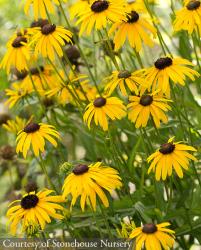
Wildly popular for her over-the-top lambent flower-power and enduring compact stature, this disease-proof selection of our native Black-Eyed Susan occurred at Andre Viette’s Virginia farm and was introduced by Blooms of Bressingham. Tidy, lanceolate deep green leaves and short, stocky upright stems lift a boundless sea of buoyant, daisy-style golden-yellow blooms with purplish cocoa-colored disks. Delighting song birds, pollinators and florists, clumping ‘Viette’s Little Suzy’ can be tucked into meadows, perennial borders, cottage gardens or massed to make a flashy statement, while it triumphs over deer, poor dry soil and air pollution.
Blooms July–September
Size: 18" – 2' 0" high x 18" – 2' 0" wide.
Hardy to zone 3.
Rudbeckia grandiflora ‘Sundance’ (P-1583)
Each $11.00
Reminiscent of a bright French parasol, ample golden-yellow petals are elegantly draped around large, pointed, purplish brown central cones, captivating finches, flower arrangers and plant enthusiasts. An exciting Jelitto introduction selected from the drought tolerant species that inhabits the western Mississippi valley, ‘Sundance’ grows tall with hairy, straight steadfast stems in no need of staking. Good-sized and oblong deep green basal leaves anchor the late blooming fiesta described by a multitude of stalks, each topped by a single sunlit flower. Consider massing in a more natural landscape or nestling into the border with Poa cita and Aster ‘Raydon’s Favorite’ for company.
Blooms August–October
Size: 3' 0" – 4' 0" high x 2' 0" – 3' 0" wide.
Hardy to zone 5.
Rudbeckia laciniata ‘Goldquelle’ (P-1552)
OUT OF PRODUCTION AT THIS TIME
Email me when this plant is available
This Rudbeckia’s sassy Dahlia-like mop of double lemon-yellow flowers promises to put a smile on your face. Perched atop wiry upstanding stems and handsome narrow-lobed green leaves, the shapely chartreuse-eyed daisies bloom for a long time, while creating a dramatic medium-sized counterpoint to Aconitum ‘Bressingham Spire’s vertical blue-violet shafts.
Blooms mid-July – September.
Size: 2-1/2' – 3' 0" high x 2' 0" wide.
Hardy to zone 4.
Rudbeckia occidentalis ‘Green Wizard’ (P-1294)
Each $11.00
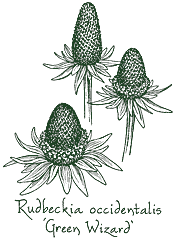
If you appreciate the curious, the unusual, the truly unique, then allow this novelty to work some magic in your garden. From a leafy green basal clump appear 3 to 5 in. wide flowers on sturdy stalks, each featuring a huge central chocolate brown boss encompassed by approximately ten large and stiff well-spaced bright green sepals.
Unparalleled as a cut flower fresh or dried, florists, gardeners and birds seek out these extraordinary blooms that first form an intriguing golden ring of pollen around their striking cones. Quick to establish and undemanding, this attention grabber guarantees a flashy display of neon color when paired with Kniphofia linearifolia and Salvia ‘Limelight’.
Blooms July–September.
Size: 3' 0" – 5' 0" high x 2-1/2' wide.
Hardy to zone 4.
Languid petals in lemon yellow shades lazily encircle prominent beehivelike, chartreuse cones during the idle days of summer. With rough surfaces and fuzzy undersides, the broad and deeply clefted green leaves attire sturdy clumping stems in an airy, opposite fashion. This Rudbeckia makes a sunny neighbor for Aster asperulus above our stone wall.
Blooms July–August.
Size: 3' 0" – 4' 0" high x 2' 0" wide.
Hardy to zone 4.
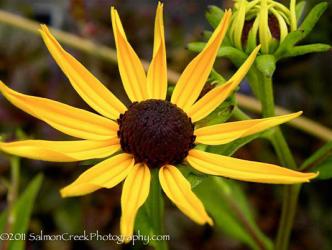
A Midwestern prairie girl that delivers outstanding flower power along with unwavering fortitude, this taller Black-Eyed Susan cousin is named for her anise-scented daisies. Radiant yellow petals surround purple-brown domed centers creating a buoyant sea of color all summer long. Perfectly branched for bouquets, the sturdy, straight-backed stems host toothed, deep green lush-looking leaves sporting downy undersides.
Blooms August–September.
Size: 4' 0" high x 2' 0" wide.
Hardy to zone 3.
Rudbeckia subtomentosa ‘Loofahsa Wheaten Gold’ (P-2250)
OUT OF PRODUCTION AT THIS TIME
Email me when this plant is available
Named after one of his beloved prize-winning Wheaten terriers, this comely late-summer bloomer was bred by Anthony Brooks, the head gardener at England’s Elton Hall. Countless ample-sized clear yellow blooms with cocoa-colored cones plus slim, widely-spaced pointed petals, which twist and undulate, cast a graceful somewhat ruffled aspect above attractive green foliage on tall stems. Kin to the stalwart Midwestern U.S. native, ‘Loofahsa Wheaten Gold’ acquiesces to dry periods and some shade, while enjoying bedfellows such as Eupatorium ‘Purple Bush’ and Persicaria ‘Fat Domino’ in sunny moderately-moist enclaves.
Blooms August–September
Size: 4' 0" – 4-1/2' high x 2' 0" wide.
Zone 3/4.
Rudbeckia triloba ‘Prairie Glow’ (P-1713)
Each $11.00
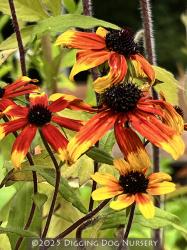
Spangled with burgundy, bronze and reddish orange shades, irresistible legions of exuberant long-blooming daisies debut dark chocolate centers and bicolored gold-tipped petals. Large trilobed verdant leaves sprout from ‘Prairie Glow’s base, forming a handsome bushy mass that gives way to upper, narrower leaves and openly-branched erect purple-flowering stems. A denizen of the Great Plains, this summertime show-stopper is not as persistent as other Rudbeckias; it eventually wears out, but easily reseeds.
Blooms July–mid-October
Size: 3' 0" – 4' 0" high x 15" wide.
Hardy to zone 3.









